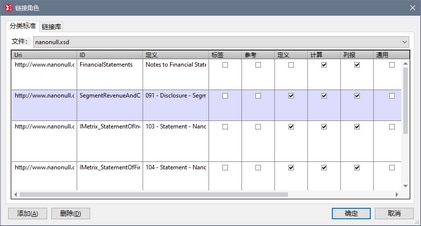关系和链接角色
当创建一组关系时,会在元素内创建这些关系。例如,当创建定义关系时,定义定义关系的元素(定位器和定义弧)都在definitionLink元素中创建,它看起来像是这样的:
<link:definitionLink xlink:type="extended"
xlink:role="http://www.nanonull.com/taxonomy/role/SegmentRevenueAndOperatingIncome">
定义链接(如上文中的定义链接)中的xlink:role特性的值必须是在定义关系上使用的链接角色之一的roleURI特性的值(参见下方片段)。链接角色(参见下方片段)包含在分类标准的appinfo元素中。
<xs:appinfo>
<link:roleType id="SegmentRevenueAndOperatingIncome"
roleURI="http://www.nanonull.com/taxonomy/role/SegmentRevenueAndOperatingIncome">
<link:definition>006091 - Disclosure - Segment Revenue and Operating Income</link:definition>
<link:usedOn>link:calculationLink</link:usedOn>
<link:usedOn>link:definitionLink</link:usedOn>
<link:usedOn>link:presentationLink</link:usedOn>
</link:roleType>
</xs:appinfo>
除了在definitionLink元素中外,链接角色还可以在其他关系种类的包含元素中使用(例如,在calculationLink和presentationLink元素中)。请注意,在上方片段中,usedOn元素指定了允许在何种关系中使用此链接角色。
要在概念定义文件(主分类标准文件)中创建链接角色,请在XBRL视图中单击菜单命令XBRL|链接角色。这将弹出“链接角色”对话框(参见下方截图)。
在“分类标准”选项卡中,从文件组合框的下拉列表中选择分类标准文件并单击添加以添加链接角色。然后,指定链接角色的URI和ID(参见上方片段)。现在指定此链接角色应该适用于的关系种类;为此,请选中所需关系种类的相应复选框(参见上方截图)。
示例文件:第六步
在“链接角色”对话框(XBRL|链接角色)中创建两个链接角色,如上图所示:
1.id="SegmentRevenueAndOperatingIncome" URI="http://www.nanonull.com/taxonomy/role/SegmentRevenueAndOperatingIncome" (to be used on definition, calculation, and presentation relationships)
2.id="FinancialStatements" URI="http://www.nanonull.com/taxonomy/role/FinancialStatements" (to be used on calculation and presentation relationships)
在下一步中,我们将为新分类标准创建关系。
